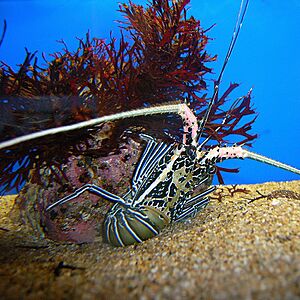Panulirus versicolor facts for kids
Quick facts for kids Panulirus versicolor |
|
|---|---|
 |
|
| Conservation status | |
| Scientific classification | |
| Genus: |
Panulirus
|
| Species: |
versicolor
|
| Synonyms | |
|
|
The painted spiny lobster (Panulirus versicolor) is a type of spiny lobster that lives in warm, tropical reefs. You can find it in the Indo-Pacific Ocean. People also call it the painted lobster, common rock lobster, bamboo lobster, blue lobster, or blue spiny lobster.
In Sri Lanka, P. versicolor is one of the three most common kinds of spiny lobster. The others are Panulirus homarus and Panulirus ornatus.
Contents
What's in a Name?
The name Panulirus comes from two old Greek words. Palin means 'backwards' and oura means 'tail'. So, it can mean 'which stands with the tail folded under the abdomen'.
The second part of its name, versicolor, is a Latin word. It means 'of different colors'. This makes sense because these lobsters are very colorful!
How to Spot a Painted Spiny Lobster
Panulirus versicolor can grow up to 40 centimetres (16 in) long. But usually, they are about 30 cm (12 in). Like all spiny lobsters, they do not have claws.
They have two spiny points, called rostra, above their eyes. They also have two pairs of large antennae. The first pair of antennae are split at the end. The second pair are hard and spiny. Both are usually white.
Their body, called a carapace, is round and very strong. It is made of a tough material called chitin. The lobster's body has white, pink, and black colors. It has stripes and a net-like pattern.
The lower part of its body, the abdomen, is green. It has black and white stripes across it. Their legs are dark blue or black with white stripes. The tail is blue-green. The tail has five yellowish parts at its base, with a blue tip and a white edge.
Young lobsters are bright blue with white lines. Their antennae bases are white instead of pink. This lobster looks a bit like Panulirus femoristriga and Panulirus longipes.
Life Cycle and Habits
Painted spiny lobsters usually reproduce in the summer. But they can have babies all year long. After a special 'love parade', the male and female mate.
The male releases a packet of sperm, called a spermatophore. This sticks to the female's underside for several weeks. The female carries her eggs, sometimes hundreds of thousands, under her abdomen.
After the eggs hatch, the baby lobsters go through a long ocean phase. They shed their skin many times as they grow.
These spiny lobsters are active at night. They like to be alone. During the day, they hide in small caves, cracks in reefs, or under corals. They are carnivores, meaning they eat meat. They eat dead animals, fresh arthropods, other crustaceans, and sometimes small fish.
Where They Live Around the World
You can find Panulirus versicolor in the western Pacific and the Indian Ocean.
In the Indian Ocean, they live along the east coast of Africa, as far south as Natal. They are also found in the Red Sea and Persian Gulf. From there, they spread across the Arabian Sea to India, Myanmar, Thailand, and Malaysia. They also live down through Indonesia to the waters of north-western Australia.
In the western and central Pacific, they are found as far north as southern Japan. They live throughout Micronesia, Melanesia, Polynesia, and in the waters of north-eastern Australia.
In 2012, one P. versicolor was found in shallow waters off Georgia, United States. It was likely set free on purpose or traveled as a baby in a cargo ship's ballast water. This was the first time this lobster was seen in the U.S. and the Atlantic Ocean.
Their Home in the Ocean
This species lives in shallow, warm tropical waters. They prefer coral reef areas. You can find them on the outer edges of reef platforms. They usually live at depths up to 15 metres (49 ft).
Why They Are Important to People
Panulirus versicolor is caught a lot for food. Because of this, they have become rare or even disappeared in some places. However, they live in a very large area, and many of these areas are protected. So, the species is not considered to be in danger globally.
People eat them throughout the areas where they live. Some people also keep P. versicolor in home aquariums.
Images for kids
-
Panulirus versicolor in Maldives. Side view





